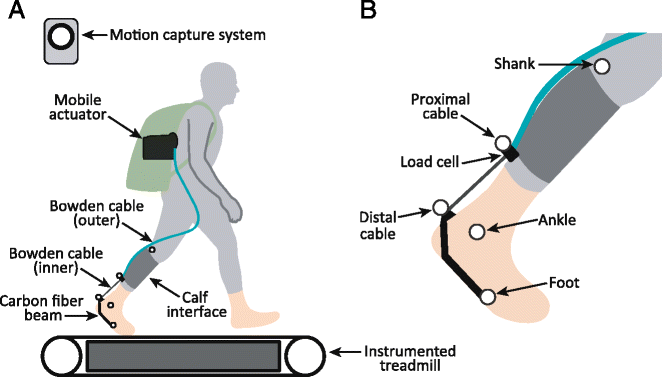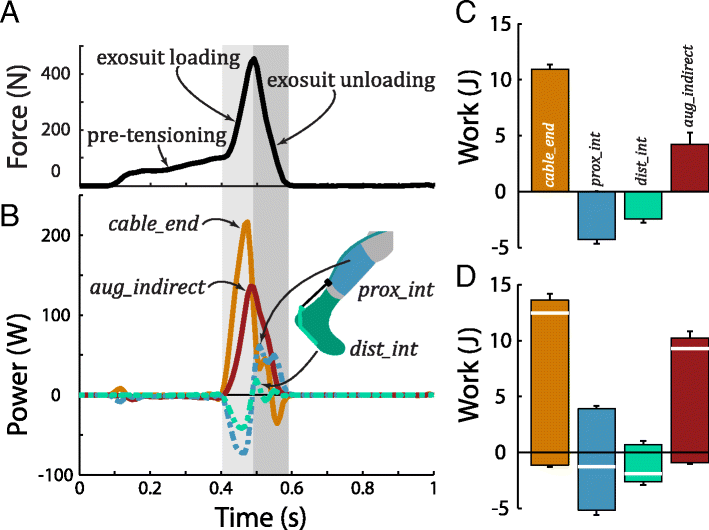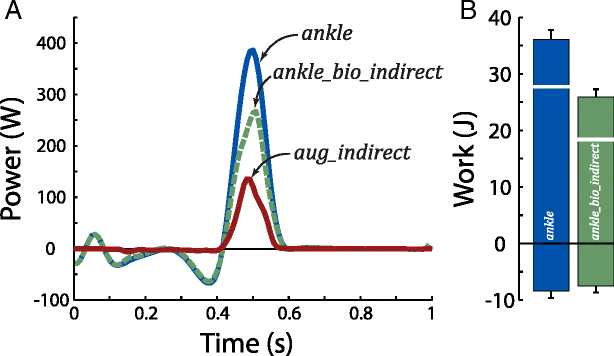Physical interface dynamics alter how robotic exosuits augment human movement: implications for optimizing wearable assistive devices
- PMID: 28521803
- PMCID: PMC5437613
- DOI: 10.1186/s12984-017-0247-9
Physical interface dynamics alter how robotic exosuits augment human movement: implications for optimizing wearable assistive devices
Abstract
Background: Wearable assistive devices have demonstrated the potential to improve mobility outcomes for individuals with disabilities, and to augment healthy human performance; however, these benefits depend on how effectively power is transmitted from the device to the human user. Quantifying and understanding this power transmission is challenging due to complex human-device interface dynamics that occur as biological tissues and physical interface materials deform and displace under load, absorbing and returning power.
Methods: Here we introduce a new methodology for quickly estimating interface power dynamics during movement tasks using common motion capture and force measurements, and then apply this method to quantify how a soft robotic ankle exosuit interacts with and transfers power to the human body during walking. We partition exosuit end-effector power (i.e., power output from the device) into power that augments ankle plantarflexion (termed augmentation power) vs. power that goes into deformation and motion of interface materials and underlying soft tissues (termed interface power).
Results: We provide empirical evidence of how human-exosuit interfaces absorb and return energy, reshaping exosuit-to-human power flow and resulting in three key consequences: (i) During exosuit loading (as applied forces increased), about 55% of exosuit end-effector power was absorbed into the interfaces. (ii) However, during subsequent exosuit unloading (as applied forces decreased) most of the absorbed interface power was returned viscoelastically. Consequently, the majority (about 75%) of exosuit end-effector work over each stride contributed to augmenting ankle plantarflexion. (iii) Ankle augmentation power (and work) was delayed relative to exosuit end-effector power, due to these interface energy absorption and return dynamics.
Conclusions: Our findings elucidate the complexities of human-exosuit interface dynamics during transmission of power from assistive devices to the human body, and provide insight into improving the design and control of wearable robots. We conclude that in order to optimize the performance of wearable assistive devices it is important, throughout design and evaluation phases, to account for human-device interface dynamics that affect power transmission and thus human augmentation benefits.
Keywords: Exoskeleton; Human augmentation; Joint kinetics; Physical human-robot interaction; Power transfer; Rehabilitation; Soft tissue; Wearable robot.
Figures





Similar articles
-
Autonomous multi-joint soft exosuit with augmentation-power-based control parameter tuning reduces energy cost of loaded walking.J Neuroeng Rehabil. 2018 Jul 13;15(1):66. doi: 10.1186/s12984-018-0410-y. J Neuroeng Rehabil. 2018. PMID: 30001726 Free PMC article.
-
Physiological and kinematic effects of a soft exosuit on arm movements.J Neuroeng Rehabil. 2019 Feb 22;16(1):29. doi: 10.1186/s12984-019-0495-y. J Neuroeng Rehabil. 2019. PMID: 30791919 Free PMC article.
-
A biologically-inspired multi-joint soft exosuit that can reduce the energy cost of loaded walking.J Neuroeng Rehabil. 2016 May 12;13(1):43. doi: 10.1186/s12984-016-0150-9. J Neuroeng Rehabil. 2016. PMID: 27169361 Free PMC article.
-
Modelling the interaction between wearable assistive devices and digital human models-A systematic review.Front Bioeng Biotechnol. 2023 Jan 10;10:1044275. doi: 10.3389/fbioe.2022.1044275. eCollection 2022. Front Bioeng Biotechnol. 2023. PMID: 36704313 Free PMC article.
-
The exoskeleton expansion: improving walking and running economy.J Neuroeng Rehabil. 2020 Feb 19;17(1):25. doi: 10.1186/s12984-020-00663-9. J Neuroeng Rehabil. 2020. PMID: 32075669 Free PMC article. Review.
Cited by
-
Ankle resistance with a unilateral soft exosuit increases plantarflexor effort during pushoff in unimpaired individuals.J Neuroeng Rehabil. 2021 Dec 27;18(1):182. doi: 10.1186/s12984-021-00966-5. J Neuroeng Rehabil. 2021. PMID: 34961521 Free PMC article.
-
Compliant lower limb exoskeletons: a comprehensive review on mechanical design principles.J Neuroeng Rehabil. 2019 May 9;16(1):55. doi: 10.1186/s12984-019-0517-9. J Neuroeng Rehabil. 2019. PMID: 31072370 Free PMC article. Review.
-
The spring stiffness profile within a passive, full-leg exoskeleton affects lower-limb joint mechanics while hopping.R Soc Open Sci. 2024 Mar 20;11(3):231449. doi: 10.1098/rsos.231449. eCollection 2024 Mar. R Soc Open Sci. 2024. PMID: 38511081 Free PMC article.
-
Continuous sweep versus discrete step protocols for studying effects of wearable robot assistance magnitude.J Neuroeng Rehabil. 2017 Jul 12;14(1):72. doi: 10.1186/s12984-017-0278-2. J Neuroeng Rehabil. 2017. PMID: 28701215 Free PMC article.
-
A Human Lower Limb Mechanical Phantom for the Testing of Knee Exoskeletons.IEEE Trans Neural Syst Rehabil Eng. 2023;31:2497-2506. doi: 10.1109/TNSRE.2023.3276424. Epub 2023 Jun 1. IEEE Trans Neural Syst Rehabil Eng. 2023. PMID: 37186529 Free PMC article.
References
-
- Bae J, De Rossi SMM, O'Donnell K, Hendron KL, Awad LN, Dos Santos TRT, De Araujo VL, Ding Y, Holt KG, Ellis TD, Walsh CJ. A soft exosuit for patients with stroke: Feasibility study with a mobile off-board actuation unit. In: 2015 IEEE International Conference on Rehabilitation Robotics (ICORR). 2015. p. 131–138.
-
- Dollar AM, Herr H. Lower Extremity Exoskeletons and Active Orthoses: Challenges and State-of-the-Art. IEEE Trans Robot. 2008;24:144–58. doi: 10.1109/TRO.2008.915453. - DOI
MeSH terms
Grants and funding
LinkOut - more resources
Full Text Sources
Other Literature Sources

